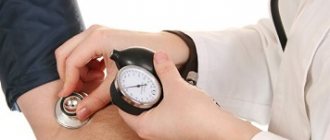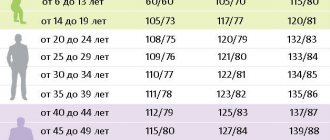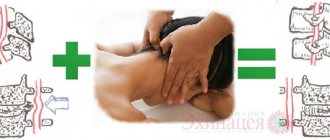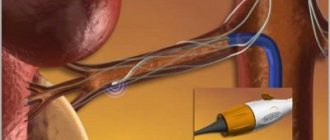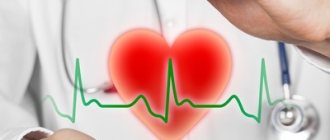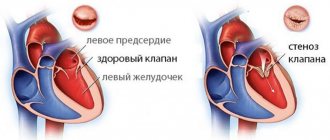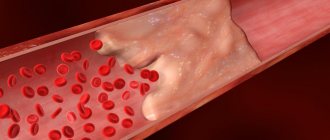The main symptom of a disease such as hypertension is a persistent increase in blood pressure, with which the heart pumps arterial blood into the body. Hypertension is dangerous due to its complications, which primarily affect the blood vessels. Strokes, heart attacks, and kidney diseases caused by their rapid wear and tear in our time affect not only long-term hypertensive patients, but also fairly young people of quite productive age. What do you need to know about this dangerous disease? What blood pressure is considered normal? Is it possible to control indicators without bringing them to a critical level?
What does pressure mean - tonometer values
When measuring pressure with a tonometer, a person receives two numerical values. More of them indicates the force with which the heart muscle pumps blood into the bloodstream. Normally, this figure should be from 120 to 135 units.
A lower value on the tonometer indicates the strength of blood movement through the human system at the moment the heart muscle relaxes, that is, at the moment when it does not push blood, but is preparing for the next push. Normally, the so-called lower pressure varies from 75 mm Hg to 90 mm.
In addition, it is important to consider the difference between lower and upper pressure. This indicator should tend to 40. That is, a value of 120/80 mm, when the lower indicator is 40 points less than the upper one, is the norm. If the lower one rises to 90 units, and the upper one drops to 115, serious problems with well-being begin.
Why does blood pressure increase or decrease?
Blood pressure numbers may change due to any diseases or without connection with the underlying pathology.
If a deviation of blood pressure from the norm is a complication of hormonal diseases, diseases of the central nervous system or neoplasms, for example, of the thyroid gland or adrenal glands, such hypo- or hypertension is called secondary. Curing the underlying disease in this case will stabilize blood pressure.
If the change in pressure is not associated with any pathology, it is called primary or essential. Essential hyper- or hypotension is a consequence of a breakdown of internal regulatory mechanisms. Treatment of such a pathology is more difficult, since it is almost impossible to establish the root cause, and therefore eliminate it. However, lifestyle changes and risk factor elimination can help keep blood pressure levels under control.
Main risk factors for hypertension:
- long history of smoking;
- low level of physical activity;
- alcohol abuse;
- a diet rich in hot, spicy foods, fatty, fried, smoked, overly salty foods;
- excess body weight;
- persistent psycho-emotional overload;
- chronic physical and intellectual overstrain.
If blood pressure is fixed at values when the lower threshold of normal has not been overcome (less than 100-100 and 65-70 mm Hg), they speak of hypotension. If during the measurement pressure values of more than 140/90 mmHg are noted. Art. – there is reason to suspect the presence of arterial hypertension.
Risk factors for developing hypotension:
- hereditary predisposition;
- prolonged stress;
- excessive physical and mental stress;
- head injuries;
- the presence of chronic, constantly recurrent diseases of the nasopharynx;
- severe infections suffered in childhood;
- occupational hazards.
Symptoms of high blood pressure
High blood pressure never goes unnoticed by a person. As soon as it begins to grow, the following symptoms appear:
- headaches localized in the back of the head;
- tinnitus;
- nausea;
- dyspnea;
- dizziness;
- purple complexion.
A short-term increase in blood pressure can occur due to stress or as a result of another psychological shock. In other cases, an increase in tonometer values is a reason for a comprehensive examination. Hypertension most often develops gradually. This manifests itself as fatigue and poor health, as well as sleep disturbances. It is important to measure blood pressure during headaches in order to notice its increase in time.
Irkutsk City Clinical Hospital No. 9
Facts about hypertension:
According to the results of epidemiological studies in our country, about 30 million people (25 - 30% of the population) suffer from arterial hypertension.
- People with high blood pressure are 3-4 times more likely to develop coronary heart disease and 7 times more likely to develop cerebrovascular accidents. In 68 out of 100 cases of myocardial infarction and in 75 out of 100 cases of stroke, patients had long-term elevated blood pressure.
- It has been proven that lowering blood pressure
- even by 3 mmHg. can reduce mortality from stroke by 8%, from coronary heart disease - by 3%.
Arterial hypertension to persistently elevated blood pressure (BP). This is one of the most common diseases.
The only way to know that you have arterial hypertension is to measure your blood pressure!
A level below 130/85 mmHg is accepted as normal blood pressure. Blood pressure between 130/85 and 139/89 is considered elevated and normal.
The diagnosis of arterial hypertension is made when blood pressure is detected above 140/90 mmHg. at least twice during repeated visits to the doctor.
Today there are three degrees of hypertension
| Degrees AG | Systolic blood pressure | Diastolic blood pressure |
| 1 | 140-159 | 90-99 |
| 2 | 160-179 | 100-109 |
| 3 | more than 180 | More than 110 |
There are no symptoms specific to arterial hypertension, but you may suspect this disease if you have:
| If these signs are present |
- attacks of “lightness”;
- dizziness;
- weakness;
- headaches, pain in the heart area;
| Measure blood pressure regularly 3-4 times a day and when symptoms appear and record the results in a diary. |
- noise in ears;
- deterioration of performance and memory;
- flashing “spots” before the eyes, double vision;
- difficulty speaking;
- numbness of the limbs;
- shortness of breath caused by exercise;
- swelling of the legs;
- visual impairment.
Regardless of whether your blood pressure is normal or elevated, be sure to check whether you have risk factors for hypertension and try to reduce their impact on your health:
| Risk factors | Results after risk factor adjustment |
| Excess body weight | A decrease in body weight by 10 kg leads to a decrease in blood pressure by at least 10 mmHg. |
| Physical inactivity | It has been established that regular physical training reduces systolic and diastolic blood pressure by 5-10 mmHg. |
| Chronic stress | With reduced exposure and elimination of stress factors, as well as rest, blood pressure decreases spontaneously. |
| Smoking | Quitting smoking helps reduce blood pressure, cholesterol, fibrinogen in the blood and platelet aggregation activity. |
| Alcohol | Reducing the frequency and dose of a single alcohol intake to 20-30 g of pure ethanol per day for men (200-250 ml of dry wine, 500-600 ml of beer) and 10-20 g for women will avoid the development of hypertension in 11% of men and in 1% of women and reduce the risk of stroke in patients with hypertension by 3-4 times. |
| Excess salt intake | Reducing the consumption of table salt to 4.5 g per day contributes to a significant reduction in blood pressure. |
| Poor nutrition | It has been established that a decrease in systolic and diastolic blood pressure in the population while following the DASH diet leads to a reduction in the incidence of coronary pathology by 15% and strokes by 27%. |
| Coffee | You should not overuse coffee, as drinking 2-3 cups of coffee can increase systolic blood pressure by 3-14 mmHg, and diastolic blood pressure by 4-13 mmHg. |
| You need to measure blood pressure: -at least 2 times a year, if the last time diastolic blood pressure was <85, systolic blood pressure <140 mmHg. -weekly, if the last time diastolic blood pressure was 85-89 mmHg. -daily if systolic blood pressure was >140 and diastolic blood pressure >89 mmHg, especially in the early morning hours from waking up to noon. |
| How to measure blood pressure correctly: 1) one hour before measuring blood pressure, you should not drink coffee or tea, and half an hour before you should not smoke; 2) blood pressure is measured at rest after a 5-minute rest; 3) the hand should be at the level of the heart; 4) clothing should not squeeze the hand; 5) the cuff is placed on the shoulder, its lower edge should be 2 cm above the elbow, the phonendoscope is installed on the brachial artery; 6) pump air into the cuff until the pulsation stops and add another 30 mmHg, then release the air at a speed of approximately 2-3 mmHg. in 1 second; 7) the appearance of pulsation will indicate the figures of systolic blood pressure, the cessation will indicate diastolic blood pressure.
9) if the shoulder circumference is more than 33 cm, it is necessary to use a wider cuff, otherwise the blood pressure numbers will be overestimated. |
Dietary recommendations for prevention and control
Diet for hypertension (DASH)
| Product groups | Number of servings per day | Portion volume | Product names | Practical significance |
| Grain and grain products | 7-8 | 1 slice of bread, 80g dry ground grain, 120ml boiled rice, oatmeal, corn flakes, etc. | Wheat bread, pita, oatmeal, rolled oats | Main source of energy and fiber |
| Vegetables | 4-5 | 160g raw leafy vegetables, 160g cooked vegetables, 180ml vegetable juice | Tomatoes, potatoes, carrots, peas, pumpkin, broccoli, turnips, cabbage, spinach, Jerusalem artichoke, beans | Foods fortified with potassium, magnesium and fiber |
| Fruits | 4-5 | 180ml fruit juice 40g dried fruit 80g fresh, frozen or canned fruit 1 medium sized fruit | Apricots, bananas, dates, grapes, oranges, orange juice, mangoes, melons, watermelons, peaches, pineapples, plums, raisins, strawberries, tangerines | Important sources of potassium, magnesium and fiber |
| Dairy | 2-3 | 240ml milk, 120ml yogurt, 45g cheese | Skim or 1% milk, skim or reduced fat butter, yogurt, cheese | Greatest sources of calcium and proteins |
| Meat, poultry, fish | no more than 2 | 84g cooked meat, poultry or fish | Choose only lean meats, remove visible fat, bake and poach meats instead of frying; remove the skin from the bird | Foods fortified with protein and magnesium |
| Nuts, seeds, beans | 4-5 per week | 42g nuts, 14g seeds, 80g cooked beans | Almonds, hazelnuts, peanuts, walnuts, beans, lentils | Rich sources of energy, magnesium, potassium and fiber |
The diet is based on eating approximately 2,000 calories per day.
Diet . It is advisable to eat food at least 4-5 times a day, distributing it according to the calorie content of the daily diet approximately as follows: breakfast before work - 30%, second breakfast - 20%, lunch - 40%. dinner - 10%. The last meal should be at least 2-3 hours before bedtime.
| YOUR ENEMIES | YOUR FRIENDS |
| Refined foods such as white bread, rice, pasta. | Cereal derivatives - bran bread, black rice, bran, oat flakes, wheat germ, muesli, barley, buckwheat. |
| Snack food - potato and cheese chips, buttered popcorn. | Nuts, almonds, fruits: apricots, bananas, oranges, grapefruit, pears, puffed popcorn. |
| Roasted vegetables, seafood, poultry. | Baked, steamed vegetables, seafood, poultry. |
| Vegetables in rich sauce, oil. | Vegetables with low-fat sauce, seafood with herbs and low-fat or low-fat cheese. |
| Milk, cheese and whole milk ice cream | Reduced fat milk, yogurt. |
| Large portions of fatty meat, sausages, sausages. | Medium portions of lean meat, meat with vegetables. |
| Pasta with cream and cheese sauce. | Pasta with tomato sauce, olive oil. |
| Pizza with fatty cheese, meat, sausage. | Pizza with vegetables, mushrooms, spinach. |
| Hamburgers, cheeseburgers, fried chicken. | Grilled chicken, baked potatoes. |
| Salads with cream sauce. | Salads with olive and corn oil. |
| Coffee, tea, lemonade, Pepsi-Cola, Coca-Cola. | Vegetable and fruit juices, nectars. |
Physical activity for the prevention of arterial hypertension
Aerobic exercise is indicated because:
- large muscle groups take part in them;
- can be carried out for a long time;
- walking, jogging, swimming, tennis, cycling, rhythmic gymnastics contribute to more intense absorption of oxygen by the body and are beneficial for the heart and blood vessels.
Aerobic physical activity ensures maximum oxygen delivery to organs and tissues, so they must be performed at a certain heart rate, which is calculated individually for each person.
| The easiest way to calculate your training heart rate: Maximum heart rate (HR) = 220 - age (years). The training heart rate should be 50% (lower limit) - 75% (upper limit) of the individual maximum heart rate. This formula is valid for relatively “healthy” people. |
- physical activity should be performed at least 4 days a week;
- The duration of physical activity should be 30-45 minutes per day.
| Anaerobic exercises (weightlifting, bodybuilding, which provide high physical activity for a short time) — for high blood pressure CONTRAINDICATED! |
In case of a sharp increase in blood pressure (hypertensive crisis), it is necessary:
- calm down and ensure a comfortable position;
- unfasten the buttons of your outerwear and open the window;
- restore breathing: take a deep breath, hold your breath and exhale slowly, repeat this several times;
- put mustard plasters on calves;
| A drug | Initial dose | Repeat dose | Tactics |
| CLOPHELINE | 0.15 mg (1 tablet) | 0.075 mg | If after 20-30 minutes the pressure does not decrease by 25% of the initial figures, then you need to take the medicine again. If 20-30 minutes after taking the pills again, the pressure has not decreased, CALL A DOCTOR. |
| CAPOTEN | 25 mg (1 tablet) | 25 mg | |
| ATENOLOL | 50 mg (1 tablet) | 50 mg | |
| NIFEDIPINE | 20 mg (1 tablet) | 20 mg | |
| NITROGLYCERINE | 0.5 mg (1 tablet) | — | |
| FUROSEMIDE | 40 mg (1 tablet) | — |
- take the tablet under the tongue (chew or dissolve), taking one of the following medicines from the first aid kit:
| Shiatsu massage techniques are also used to reduce blood pressure. In this case, a soothing method of influencing massage points is used, i.e. continuous, smooth pressure with a gradual increase in pressure over 3-5 minutes. The massage points are shown in the figure. |
Share
Ways to lower pressure
Before taking any measures, you need to make sure that the malaise is associated with high blood pressure. Therefore, anyone who suffers from frequent headaches, sleep disturbances or loss of strength needs to have a tonometer at home - a device that measures blood pressure. Headache and general weakness can occur with both low and high blood pressure. Taking the wrong medication can be a fatal mistake.
Pharmaceutical companies produce many drugs that can normalize blood pressure. Most of them are analogues of each other, so it is important to pay attention not to the name of the drug, but to the active substance underlying the medication.
Self-administration of blood pressure-lowering pills is unacceptable, because it is important to know what exactly caused the increase in blood pressure. Among the variety of drugs, it is important to choose one that will return the tonometer readings to the acceptable limits of the norm, having a beneficial effect on the cause of the jump. Universal drugs that knock down the tonometer column by several points can be taken only as a last resort, when it is not possible to obtain prompt consultation or the patient’s condition is extremely dangerous: the upper indicator tends to 180-190mm.
When a doctor diagnoses hypertension and prescribes taking the drug in a certain dosage, the prescription cannot be ignored. Such patients are forced to take pills to lower their blood pressure every day at a certain time in order to keep their blood pressure levels within normal limits. A single missed dose of the drug will lead to an immediate attack of hypertension.
For patients with nephritis and other renal dysfunction, it is important to remember that almost all diuretics sharply reduce blood pressure. Therefore, the use of diuretics by hypotensive patients should be under the supervision of a specialist.
Ways to alkalize the body
There are several ways to restore the acid-base balance. The best way is to change your diet. Ideally, 70% of your daily diet should consist of alkaline foods and no more than 30% of acidic foods.
rinse your mouth with a baking soda solution for 3 minutes or longer after each meal To prepare a soda solution, pour a teaspoon of soda into a glass of boiling water and stir until all the carbon dioxide bubbles are released. Then the solution is ready.
Soda wraps also, due to the removal of salts deposited in soft tissues, lead to a gradual alkalization of the internal environments of the body. You can use only socks, you can use knee socks, stockings or even tights. You can also do body wraps. Only clothes should be cotton, not synthetic.
Socks (or other clothes) must be soaked in a soda solution prepared according to the same recipe and put on. A plastic bag is put on top, and another (dry) sock is placed on top of it. These wraps should be done at night. The key is to keep your skin alkaline and moist throughout the night.
Sometimes in the morning, after washing off the soda solution, skin irritation and itching appear. It can be easily removed by wetting these areas of the skin with an acidic solution (vinegar or citric acid, highly diluted).
Reducing blood pressure without the use of medications
First of all, you need to remember that the first attack of a pressure surge is a reason to purchase a home blood pressure monitor. If signs of hypertension appear, and there are no drugs that can normalize the condition, to relieve the symptoms you need to do the following:
- Provide rest to the body by taking a semi-sitting position.
- Get rid of tight and suffocating clothes (unbutton your shirt, take off your scarf).
- Move closer to a source of fresh air - open a window/turn on the air conditioner.
- Disturb the patient as little as possible with worries and exclamations about his terrible appearance caused by an attack of hypertension.
- Drink green tea or a hibiscus drink made from hibiscus flowers.
- Avoid eating salty foods, as salt, by retaining water in the body, leads to edema and increased blood pressure.
- If after 15 minutes it does not get better, call an ambulance.
You can help relieve the condition by applying wet, cold towels to your forehead.
How to measure pressure correctly
Rules for measuring blood pressure (BP):
Blood pressure is measured when a person is at rest: no earlier than 1.5–2 hours after eating, smoking, drinking coffee and other tonic drinks.
The best position for measuring pressure is when the person is sitting on a chair and the hand on which the pressure is supposed to be measured is placed on the table. The part of the arm on which the cuff is applied must be freed from pressure clothing and the muscles relaxed, as muscle contractions can lead to incorrect results.
The cuff, depending on the type of tonometer, is applied either to the lower third of the shoulder, not reaching 2.5 cm to the upper edge of the cubital fossa, or to the wrist.
While the tonometer is operating, it is important to maintain a motionless posture, do not move your hand, do not talk, or worry.
For the first time, the pressure is measured on both hands. If the difference between the readings does not exceed 10 mm Hg. Art., then subsequent measurements are usually performed on the non-working hand - for right-handers on the left, for left-handers - on the right. If the indicators differ by more than 10 mm Hg. Art. it is necessary to measure the pressure on the arm, where large numbers are recorded.
It is necessary to measure blood pressure, especially for people who have already been diagnosed with hypertension, twice a day: in the morning an hour after waking up and in the evening before going to bed. The number of measurements during the day varies depending on how you feel, if alarming symptoms appear indicating increased blood pressure.
Patients measuring blood pressure at home are advised to record the results in a special diary. Such blood pressure monitoring allows you to monitor blood pressure levels and evaluate the effectiveness of medications used to reduce blood pressure.
Blood pressure is measured using a special tonometer device.
Two modifications of tonometers are used:
- Mechanical
- Semi-automatic
Mechanical aneroid sphygmomanometers are used mainly in medical institutions, since their use requires certain knowledge and skills. The cuff is placed on the shoulder, air is pumped into its chamber using a rubber bulb, and tones are listened to using a phonendoscope.
For home use, it is better to use automatic or semi-automatic models of tonometers.
A semi-automatic tonometer works on the following principle: a cuff is fastened on the wrist, air is pumped into it with a bulb, which soon comes out automatically. At the end of the measurement, the results appear on the display.
To operate the automatic blood pressure monitor, simply place the cuff on your wrist and press the start button. All other actions occur automatically. Various types of automatic tonometers have been developed: with a shoulder cuff, wrist, finger.
Products that affect blood pressure
Not only medications, disturbances in the functioning of certain organs and experiences, but also food products available in almost every refrigerator can increase or decrease blood pressure:
- Ginger. It relieves vascular spasm, making them more elastic and pliable in response to the influence of blood flow, as well as to temperature conditions. If the vessels can dilate in a timely and uniform manner, this will not cause high blood pressure on their walls.
- Garlic not only thins the blood and helps fight blood clots, but also helps lower blood pressure.
- Lemon, containing a large amount of vitamin C, provides the walls of the blood flow system with a reliable building material, due to which arteries, veins and blood vessels gain strength and elasticity.
People suffering from hypertension need to give up chocolates in particular and sweets in general. The sharp release of energy that occurs when consuming glucose also provokes a jump in blood pressure. You can eat dessert, but only on a full stomach, and in moderation.
Perform the exercise in the other direction
1. We spread our arms to the sides at 90 degrees and turn our palms up.
2. Bring your palms together above your head.
3. Turn your head to the right and hold this position for 5 to 15 seconds.
4. We return to the starting position in the reverse order - first the head, then the hands.
Exercise "Goose"
I. Purpose of the exercise
The Goose exercise is designed to increase the elasticity and flexibility of the neck. At the same time, deep muscles are worked out, which can compress blood vessels, arteries and nerves.
Working out the deep muscles leads to normalization of blood flow in the vessels and prevents pinching of the nerves.
This exercise is the most effective of the entire complex. However, you should not limit yourself to just doing it. Tangible results can be achieved only by performing all the exercises of the technique.
II. Initial position
The exercise is performed while sitting on a chair. We sit closer to the edge of the chair so that our back does not rest on the backrest. The back is straight. The face looks forward. Hands are lowered along the body.
Note! A detailed description of the starting position with photographs is given in the topic “Warm-up with dumbbells.”
Procedure for performing the exercise
1. Move your head forward as much as possible. The face looks straight and should not tilt.
2. Turn your head to the right and stretch the tip of your nose to your armpit.
3. Stretch until tension appears under the back of the head.
Completing the exercise
We complete the exercise strictly in the reverse order, observing the trajectory of movement.
1. Turn your head so that your face looks forward.
2. Return the head back to its original position.
Dr. Strelnikova’s complex against hypertension
Doctor Strelnikova, whose methods have long been used by modern cardiologists, also recommended lowering blood pressure with exercises. To achieve tangible results, you need to do gymnastics regularly every day. The course is 2 months.
The basis of the technique is correct breathing.
- Palms. Stand up, fold your arms so that your palms are at shoulder level. Turn your palms forward. Take a powerful breath through your nose, while clench your fists. Exhale and loosen your hands again.
- Shoulder straps. Bend your arms so that your fists are at shoulder level. Inhale loudly, lowering and straightening your arms. Exhale, and enter the I.P.
- Horse. IP - any comfortable position in which the back remains level. Relax, take 4 deep breaths through your nose without interruption. Hold your breath for a couple of seconds and slowly return to the starting position.
- Pump. Place the legs at shoulder level. Bend over so that your back is slightly rounded. Inhale the air forcefully, straighten up, and only then exhale.
- The cat exercise is performed while standing. Bend your elbows and place your palms behind you at lower back level. Take a deep breath and turn to one side. Turn back and exhale calmly. Repeat everything from the beginning, but for the other side. At the same time, breathe noisily and deeply.
- Pendulum. Inhale and bend forward. As you exhale, straighten up and hug yourself with your arms. Turn your neck first in one direction and then in the other. Inhale during the turn, exhale during the starting position.
- Ears. Tilt your head towards one of your shoulders. While bending over, take a deep, powerful breath. Exhale while straightening your neck.
- Pendulum head. Inhale, while tilting your head forward, and as you exhale, return to the i.p.
Interesting! When performing exercises to normalize pressure according to the Strelnikova system, you should pay special attention to proper breathing. Inhalation is done through the nose and exhalation through the mouth. All actions should be performed about 6-8 times. With adaptation to loads, you can increase the number of repetitions. If your health deteriorates, it is better to temporarily interrupt exercise therapy.
Material on the topic: What exercises can you do after a heart attack.
Physical therapy to lower blood pressure using the Shishonin method
Dr. Shishonin’s exercises for hypertension will help you get rid of high blood pressure, headaches, migraines, sleep problems and other unpleasant manifestations of the disease through the effect on the cervical spine.
Here are the following exercises to reduce blood pressure:
- Metronome. Sit on a chair, tilt your head left and right, holding each side for 30 seconds.
- Spring. Tilt your head as far down as possible so that your chin touches your chest. Freeze for 30 seconds. Then stretch your neck forward and freeze again. Move your head to the side, and again do not move for 30 seconds. Go back to the beginning. Perform 4-5 turns on each side.
- Fakir. Place your palms behind your neck. Bend your elbows as tight as you can. Turn your head from left to right, freezing in each direction for half a minute.
- Heron. IP - sitting. Place your palms on your knees. Stretch your chin up while looking at the ceiling. At the same time, move your arms back. Hold for 5 seconds. Bring your chin down and your arms forward. Rest and do it all again.
- Goose. IP - standing. Position your head so that your chin is parallel to the floor. Pull your neck forward until you feel pain. Stop for 2-3 seconds and return to the starting position. Rest and repeat everything from the beginning again.
These 5 exercises for hypertension will normalize blood pressure, relieve headaches, and help increase strength and energy. Dr. Shishonin recommends performing neck exercises for hypertension efficiently and slowly, so as not to provoke an exacerbation of hypertension.
Video: Dr. Shishonin's exercises
Exercise therapy complex for normalizing blood pressure using the Buteyko method
Exercise therapy for hypertension, which was proposed by the doctor and scientist Konstantin Buteyko, has an extremely beneficial effect on the body: it saturates the organs with oxygen, strengthens blood vessels, and improves blood flow.
Important! According to Buteyko’s observation, the complex will help the patient completely get rid of the disease. Physical exercise normalizes the relationship between the volume of carbon dioxide and oxygen in the body.
Main rules of implementation:
- Gymnastics is performed while sitting, the body is relaxed, and the gaze is directed upward.
- Inhale through your nose, exhale through your mouth, breathe evenly, do not use the full volume of your chest.
- If you feel short of breath, take a deep breath.
If the execution goes correctly, a feeling of spreading warmth appears throughout the body, which intensifies with each new activity.
Exercises for high blood pressure are performed on an empty stomach. You need to inhale as silently as possible through your nose:
- Breathing is performed from the upper part of the lungs. Inhale and exhale for 5 seconds, then take a break for 5 seconds (do not breathe). Complete 10 repetitions in total.
- Breathe with your stomach and chest. At the same time, you can visually observe the movements of the chest and abdomen. Just 8 seconds to perform, and 5 seconds to rest (hold your breath). Perform 10 repetitions.
- Hold your breath for 7-10 seconds and massage your nose.
- Breathe 20 times on each side of your nose.
- Take in the air, pull in your stomach for 8 seconds, exhale, returning to IP for 8 seconds. Pause for 5 seconds and repeat everything from the very beginning 10 times.
- Do 12 powerful inhalations and exhalations in a minute. As you exhale for the last time, hold for 5 seconds. Return to i.p.
 to obtain accurate data on blood pressure levels, at least two measurements should be performed;
to obtain accurate data on blood pressure levels, at least two measurements should be performed;
